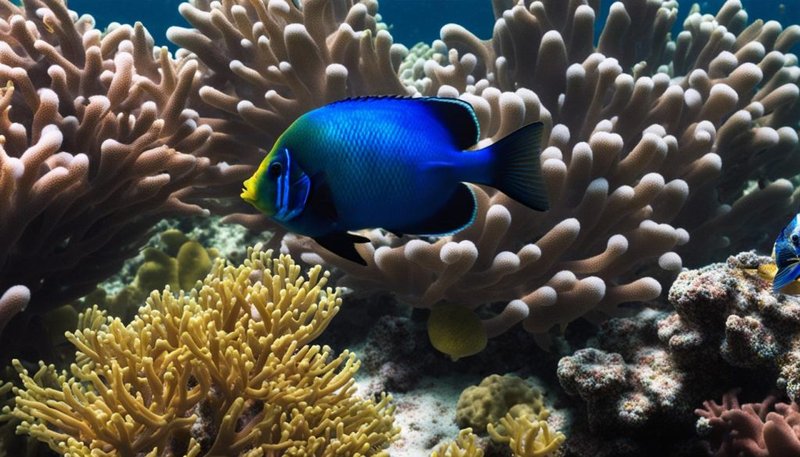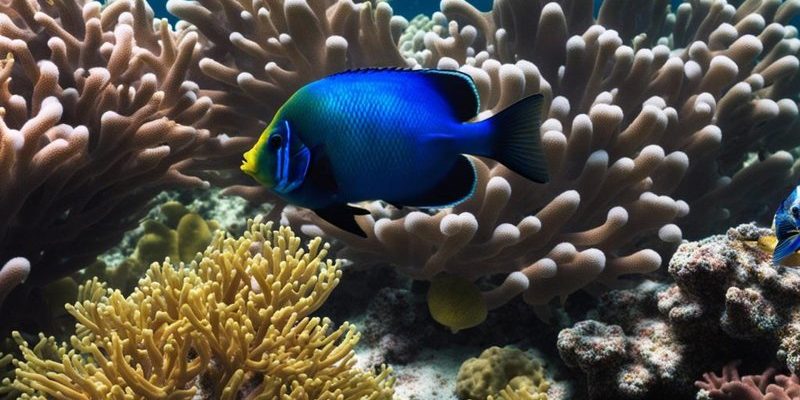
Damsel fish, particularly those from the *Pomacentridae* family, are popular among aquarium enthusiasts for their hardiness and bright colors. They bring a lively energy to any tank, but compatibility with corals can be a concern. In this article, we’ll dive into the world of damsel fish, explore their temperament, and help you understand how they can fit into a reef environment.
Understanding the Damsel Fish
Damsel fish are small, spirited fish found in tropical and subtropical waters around the world. These fish typically range in size from two to four inches, making them perfect for smaller aquariums. They come in a variety of colors, from electric blue to vibrant yellow, which instantly catch the eye.
What makes damsels particularly appealing is their hardiness. They can adapt well to various water conditions, which is why they’re often recommended for beginners. However, this toughness can come with a price; damsels can sometimes exhibit aggressive behavior, especially as they establish their territory. Imagine a feisty little bulldog that might be less than friendly with newcomers in its yard!
Are Damsel Fish Reef Safe?
When it comes to the question of reef safety, the answer is a bit nuanced. Generally, damsel fish are considered reef safe, meaning they typically won’t harm healthy corals. However, their behavior can vary from species to species—and even individual to individual.
While they usually leave corals alone, some damsels may nip at smaller polyps or attack other fish as they establish dominance. This is where diving deeper into the specifics becomes crucial. For instance, species like the blue damselfish are known for their territorial nature and can be aggressive, especially when breeding.
Common Damsel Fish Species
To better understand their compatibility, let’s look at a few popular damsel species:
- Clownfish Damsel: Quite social and easier to manage within a community tank.
- Blue Devil Damsel: Beautiful but can display more aggressive behavior toward tank mates.
- Yellowtail Damsel: Generally peaceful, but still should be monitored closely.
Choosing the right species is key to ensuring a harmonious reef environment.
Compatibility with Coral
So, you might be wondering how these fish interact with coral specifically. Most damsel fish tend to leave larger corals alone. However, certain smaller or more delicate corals can be at risk. Think of these corals as shy friends who don’t appreciate a pushy personality—they might get nipped at if a damsel is feeling particularly territorial.
Soft corals, like mushrooms, are often more resistant to damsel fish behavior. On the other hand, stony corals, which have more rigid structures, can be a bit more vulnerable. The general rule of thumb is to introduce damsel fish carefully and monitor their interactions with your coral.
Creating a Balanced Tank
To ensure your tank remains balanced, consider these tips:
1. Choose Your Fish Wisely: If you’re planning a reef tank, opt for damsel species known for their peaceful nature.
2. Provide Plenty of Hiding Spots: Adding rocks, caves, and corals can help reduce aggressive behavior by providing natural habitats.
3. Introduce Fish Gradually: Integrate new fish slowly to minimize stress and territorial disputes.
By carefully planning your tank, you can reduce the chances of conflict and promote a peaceful coexistence.
Signs of Aggression
Even the most compatible fish can sometimes display aggressive behavior, especially when it comes to territory. Here are some signs to watch for that indicate your damsel fish might be a little too feisty:
– Nipping at Tank Mates: If you see your damsel frequently chasing or nipping at other fish, this can lead to stress.
– Hiding Behavior: Other fish might retreat and hide more than usual if they’re feeling threatened.
– Injuries Among Tank Mates: Look for marks or injuries on your other fish, which can be a direct result of aggression.
Recognizing these signs early can help you take action, like rearranging the tank or adding more hiding spots.
Alternatives to Damsel Fish for Reef Tanks
If you’re feeling hesitant about adding damsel fish due to potential aggression, there are plenty of peaceful alternatives to consider for your reef tank. Here are a few options:
- Cardinalfish: Peaceful and colorful, they get along well in community tanks.
- Gobies: These bottom-dwellers provide a unique dynamic and are known for their calm nature.
- Clownfish: Iconic and friendly, they also have a well-documented good relationship with anemones.
These alternatives can add liveliness and color to your reef without the concern of aggression.
In summary, the question of whether damsel fish are reef safe largely depends on the species you choose and the dynamics of your coral environment. While many damsels can thrive in reef tanks, their behavior varies, and compatibility will require a bit of observation and care.
Remember, creating a peaceful and diverse reef tank is all about balance and understanding your fish’s personalities. So, whether you decide to go with damsel fish or opt for a more peaceful community, the most important thing is to enjoy the beauty of your underwater world. Just like a well-tended garden, a thriving reef brings joy, life, and harmony into your space. Happy fishkeeping!

